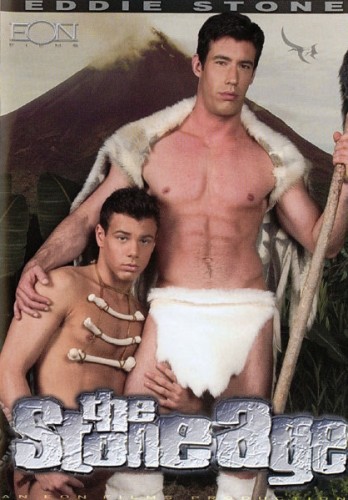The Czechs just discovered the world’s first gay caveman.
Problem? He’s probably not gay and definitely not a caveman. She may not even be much of a tranny.
The Telegraph and The Daily Mail both reported with utter credulity the claim of Czech archaeologists that a male skeleton has been found buried in a manner consistent with female burial in a grave from the central European Corded-Ware Culture (~2900 BCE to ~2300 BCE). But MSNBC headlined its article “‘Gay Caveman’ gets rocky reception,” and subheads it “Definitely not a caveman, and could be a third gender, archaeologists warn.”
“Bone Girl” blogger Kristina Killgrove calls the reporting “insane sensationalism,” in her post titled “Gay Caveman! ZOMFG!” And John Hawks, a paleoanthropologist at the University of Wisconsin, Madison, questioned the account, telling Live Science:
Not only is “gay” an oversimplification, “caveman” is flat-out inaccurate…Corded-Ware burials are not ‘caveman’ in age…We’re talking about pre-Bronze Age farmers.
[Link.]
With agonizing confusion, the researchers and the British press both seem to have mixed up “gay,” “transsexual,” and “transvestite,” and in my opinion are going way too far into jumping the conclusion that the information presented indicates any of those.
Most of the mix-ups in this article seem to originate with the archaeologists, who — it seems painfully obvious — are both jumping to conclusions and either using the English language in imprecise ways, or being awkwardly translated. I have no idea if these scientists were speaking in English, but discontinuities in the different accounts of the press conference make me think the comments may have been translated by a third party.
But then, what do I know? I’m just a caveman.
Here’s what The Telegraph says:
The male body – said to date back to between 2900-2500BC – was discovered buried in a way normally reserved only for women…with its head pointing eastwards and surrounded by domestic jugs, rituals only previously seen in female graves.
“From history and ethnology, we know that people from this period took funeral rites very seriously so it is highly unlikely that this positioning was a mistake,” said lead archaeologist Kamila Remisova Vesinova…”Far more likely is that he was a man with a different sexual orientation, homosexual or transsexual,” she added.
…”We believe this is one of the earliest cases of what could be described as a ‘transsexual’ or ‘third gender grave’ in the Czech Republic,” archaeologist Katerina Semradova told a press conference on Tuesday.
[Link.]
But wait!!! The Daily Mail reports those exact same comments as the following:
“This later discovery was neither of those. We believe this is one of the earliest cases of what could be described as a transvestite or third-gender grave in the Czech Republic.”
[Link.]
Sooooooooooooooooooooooo…are we talking about transvestites, transsexuals, “third-genders”…or someone who’s gay? Queer? Bi-curious? Straight but gay-friendly? Is this a Cavemetrosexual? Could we maybe be discussing a cave-four-beer-queer? Or does it just not, you know, matter, because this stuff is translated and at this point we have no idea?
Or could we be talking about the most obvious application of Occam’s Razor here, which seems obvious from what was reported in the Telegraph article:
The skeleton was found in a Prague suburb in the Czech Republic with its head pointing eastwards and surrounded by domestic jugs, rituals only previously seen in female graves.
[Link.]
Got it? Skeleton. Skeleton. Isn’t it much more likely that this is the skeleton of someone with essentially male skeletal structure, and potentially male chromosomes, who presented in life as a female? It’s not what I would call incredibly common, but it’s not that uncommon, either.
Remember John Hawks? Here’s what he said about that:
Hawks said the third-gender claims are difficult to evaluate without a formal archaeological description.
“I haven’t seen any evidence that really convinces me that the skeleton is male,” he said. “It could be, but the photo is not convincing on that point, and I have not seen any claim of DNA testing.”
It’s tough to assign a sex to a skeleton with certainty, Dobson said. Archaeologists and anthropologists usually rely on bone measurements, particularly the size and shape of the pelvis. But these estimates aren’t exact, Dobson said.
“There have been cases in the past where a gender was assigned and we have gone back to look and assigned the opposite gender,” he said.
[Link.]
Killgrove echoes my sentiments about how whack-ass the conclusion-jumping is:
After confirming the gender, the second step would be to determine how many examples of gendered Corded Ware burials there are.
“Is this burial unique out of 20 burials or unique out of 20,000 burials?” Killgrove told LiveScience. “That makes a big difference in interpretation.”
[Link.]
Regardless, the information is, in my opinion, way too sketchy to indicate anything specific about gender identity vs. birth gender — let alone sexual orientation, which the researchers (presumably not native English speakers) have confused (forgivable) and which confusion the science reporters have allowed to pass without comment (unforgivable).
For the sake of looking at this from a scientific perspective, though, I feel like we need to drop the language confusion. It may be major in modern terms, but the problem comes in even using them in the first place. It doesn’t take any knowledge of “homosexual,” “transsexual” and “third gender,” not to mention “orientation” and “gender identity” to start picking this report apart.
Those terms, clearly, vary hugely from culture to culture. Sex-positive, queer-positive and trans-positive sources don’t usually confuse them all that much, but they do sometimes confuse archaeology. Meanwhile, things like gender identity, marriage rituals, and same-sex contact are fantastically difficult to assess in anything like detail in a five thousand year old grave, especially since this is “one of the earliest cases” — that is to say, the first one I know about.
Oh, speaking of which — far more erroneous is the implication offered by Vesinova’s comment that “…Archeologists had uncovered an earlier case dating from the Mesolithic period where a female warrior was buried as a man.”
The obvious implication is that what she called “third-gender” identity was not that uncommon in Corded Ware culture. Except that the grave we’re talking about now isn’t from the Mesolithic period. The Mesolithic period ended the latest in Northern Europe, where it was done by somewhere between 5,000 and 4,000 BCE — at least a thousand years before the earliest possible date for the grave we’re talking about now.
Would you generalize Parisian gender identity from Norman burial rituals? Yes, I know that’s a shitty comparison — the difference between AD 1000 and AD 2011 is not comparable in practical terms to the difference between 4,000 and 2,900 BCE. But regardless, the article doesn’t specify whether we’re even talking about a central European case in which a woman was buried with warriors — we definitely aren’t talking about Corded-Ware culture, because as far as I can tell, there was no Corded-Ware culture in the Mesolithic era (or for 1,000 years beforehand).
Any of which could be sorted out and explained by an expert, probably. It could also have been sorted out if the researchers had been more specific about WTF they were talking about, or reporters had thought to either track down the point’s significance — or omit it because it gives the wrong impression — or, at the very least, a questionable one.
But add that to archaeologist Katerina Semradova’s comment at the Cave Gay press conference (paraphrased by the Telegraph author) that “Siberian shamans, or latter-day witch doctors, were also buried in this way but with richer funeral accessories to appropriate to their elevated position in society,” and (quoted) “But this later discovery was neither of those, leading us to believe the man was probably homosexual or transsexual.”
I’m left scratching my head at that shit. Shamans? Latter-day witch doctors? Who the hell writes an article on central European anthropology and thinks that the word “shaman” needs to be described as “latter-day witch doctor”?
And the connection between Siberian and Corded Ware Culture is…what?
The answer is that Corded Ware Culture may have descended from cultures on the steppes of Central Asia. However, while that view is supported by some authors, is strenuously argued against by others. Therefore, while it might be good for indicating a connection between two sets of burial rituals I would argue that it’s fairly questionable to use that to establish a lack of connection, especially with something that is clearly a powerful deviation from previous established science. Isn’t it true that extraordinary claims require extraordinary evidence?
But more important…are we talking “Latter-day witch doctors” or not? Do you mean today’s Siberians? She’s using the burial rituals of today’s Siberians to establish that our suburban Prague resident was a tranny? Or was she talking about Siberians contemporary to the Corded Ware Culture? The Telegraph article doesn’t tell me — but regardless, I think using Siberian rituals for “elimination” to then establish this unusual thing that’s never happened before. As I see it, the logic goes like this:
Observation: Subject’s skeleton appears to be male; burial was inconsistent with other burials of males in this culture, which would have been consistent in gender terms with a possibly-connected culture in Siberia, had there been evidence that this person was of an elevated class.
Conclusion: Tranny!!! Cavegay!!! ZOMFG GTFOH w00t! w00t! w00t!
It’s kinda maybe not the best logic.






Zen — I second what Violet said. No disrespect to anyone from across the gender spectrum is intended here. I am, in fact, giving a talk on gender transition and surgery this weekend, which I do every six months, from an enthusiastically trans-positive perspective.
My jocular tone is aimed at dicey science and bad science reporting laced with sensationalism and credulity, not trans people.
Hi Zen, thanks for stopping by and commenting. I understand what you are saying. We meant no insult whatsoever – please do not interpret intent. Also, take a moment to understand our relationships to trans issues and trans people, and familiarize yourself with our work. Especially that work in the trans communities in San Francisco, where the people we work with, learn from, and volunteer with often refer to themselves freely as “tranny.”
The word “tranny” is used on this blog quite a bit, and is used on a lot of the trans blogs I link to. I consider it A LOT different form the “n” word and use it respectfully – with my trans family, partners and friends – as does my colleague.
I found a reaction like yours to the word “queer” when I went to London recently. It is used with pride in these parts, but there it is still taboo. I used it mindfully. Same with “fag” which is perfectly acceptable in most of my circles here in SF.
As our community circles overlap on the internet and are no longer bound by location-to-terminology or subculture-to-terminology, we’re bound to find friction in spots.
In my opinion, “tranny” is nowhere near the “n” word in its insidiousness and evil, and no, I don’t have the right to use the “n” word and I never will. But the “n” word is in a lot of lyrics to music I like. Still, I don’t want to see it on my blog, and I am going to edit your comment so that word doesn’t get crawled and connected to my blog. I think your comparison goes too far.
Please don’t take it the wrong way.
Also, this post is not to be taken too seriously.
PS: a tranny works here at tinynibbles, and this is how she identifies. She is happy for me to refer to her as a tranny. I can’t speak for all trans people – neither can she, and neither can you. But the difference is that no one is okay being referred to as the “n” word. The history of the slang is important here.
Uh, good article… But, are you aware that the word “tranny” is considered a slur by many trans people, similar to “n****r” or “faggot?” While some transgender people use the term to describe themselves, it is generally considered among many transgender people to be inappropriate for a cisgender person to use the term.